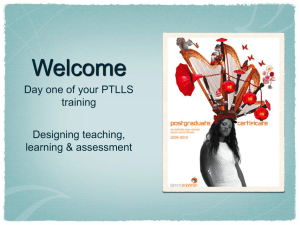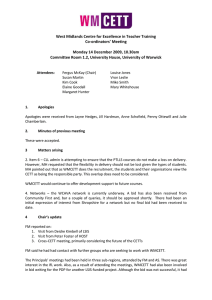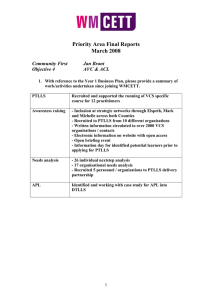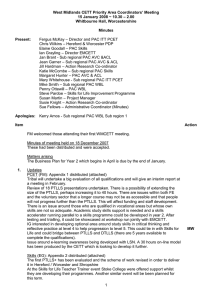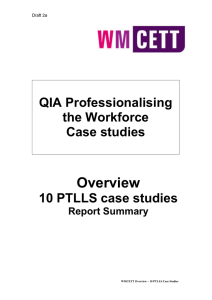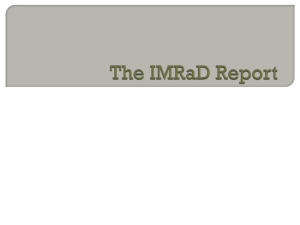PTLLS 2 - practical
advertisement
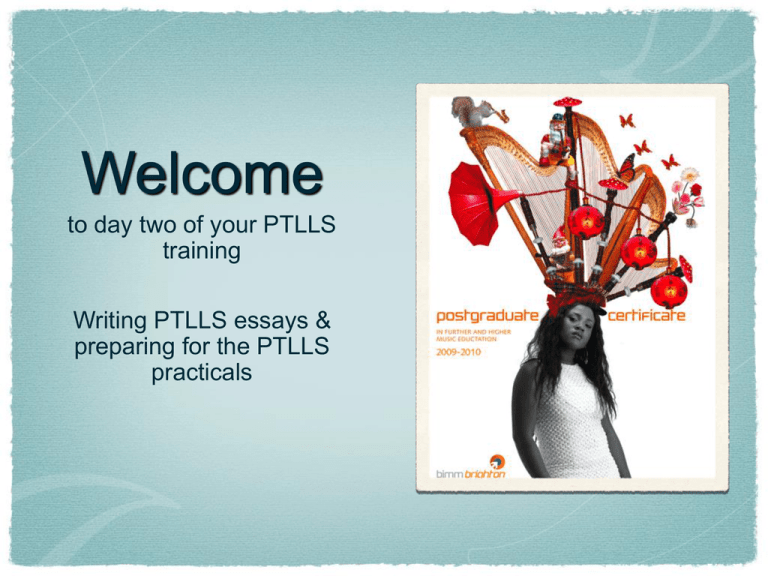
Welcome to day two of your PTLLS training Writing PTLLS essays & preparing for the PTLLS practicals A reminder - our aims are to: Develop our big-picture thinking about teaching, learning & assessment (TLA), and start to create some ‘maps’ of TLA Start to develop and use the language we need to be able to talk about TLA in an informed, critical way Crack on with PTLLS! Mini-essay peer review In your pair / 3, swap essays and identify: The best thing about each essay One thing you think could be improved / isn’t clear in each essay One thing you have learned from reading each essay that you could use to improve your own Try to generalise from this to produce a short ‘how to’ guide on writing good PTLLS theory essays (a few bullet points = perfect!) Mini-essay review Stage 2 Now you are going to have a look at a different set of essays from the one you wrote yourself Read them - discuss and identify the good aspects and things you can learn from these - and add to / amend / adjust your ‘how to’ guide if you want to At each stage, note good things you could use yourself! Finally - we’ll compare our ‘how to’ guides. PTLLS Practical assessments PTLLS practical assessments 1 Produce a learning programme/scheme of work in your subject area, for a minimum of six sessions (the length of each session is to be agreed between yourself and your tutor). Use Form 3 in Appendix 1. I’ll give you an example from Gravells, A. (2008) Preparing to Teach in the Lifelong Learning Sector (3rd edition) (Exeter: Learning Matters, Ltd.) p.111 You don’t have to invent these, you can use sessions from the BIMM courses you are actually teaching. PTLLS practical assessments 2 Produce a session plan (this can be from the scheme of work or different) for a minimum of 30 minutes. Use Form 4 in Appendix 1. (We’re going to work on this together today) 3 Deliver the teaching practice session (i.e. the one in your plan), demonstrating a selection of teaching and learning approaches to engage and motivate learners. You need to communicate appropriately and effectively with learners. (Minimum 30 minutes of delivery). PTLLS practical assessments 4 Explain and justify the reasons behind your choice of teaching and learning approaches and use of resources for one of your delivered sessions. Recommended word count: 150-250 words. (We’re going to use the same session for this as well - so it all links up.) 5 Obtain feedback from your tutor/observer, and complete a self evaluation to reflect and evaluate the effectiveness of your own teaching. Use Forms 6 and 7 in Appendix 1. (Still the same session!) PTLLS practical assessments (kinda!) 6 Complete a reflective learning journal after each assessment task completed and / or session attended throughout the PTLLS programme. Use Appendix 5. 7 At the end of the programme, complete a summative profile and action plan. Use Form 9 in Appendix 1. PTLLS Session planning process - with bags of peer feedback and support :-) Constructive Curriculum Alignment Decide the learning outcomes Decide the course content Decide the assessment & grading criteria Choose the teaching & learning activities (Teacher? Peers? Individual students?) Choose how students get feedback (When? What on? Who from? How?) Choose the assessment method(s) (Teacher? Peers? Individual students?) Think about how you’ll evaluate the course (during & after) Some thinking processes What do I want them What’s going to to be able to do? be on the course? How will I know & they know if they’ve been successful & how well they’ve done? What are we all going to do to help them get there? Why are we doing it this way? How will they know how well they’re doing as they’re going along & what they need to work on? How can I assess them fairly, reliably, validly? Why is this the best way? What am I looking for to tell me if this is working? Forms, forms, forms Appendix 1, Form 4 is what you need for this! Let’s start with the Aims and Learning Outcomes Aim = your overall intention for the session Learning Outcome = goal = what you want the student to be able to do by the end of the session (expressed clearly & simply and written for the benefit of the students themselves) NB - at BIMM we use learning outcomes, not ‘objectives’ (which are just slightly more specific aims, and which we don’t think are as good as proper outcomes). For example, for this session right now Aim = to introduce students to session planning skills, or to practice session planning skills What’s wrong with these ‘learning outcomes’, though? Session planning The learner will be able to understand session planning The learner will improve their ability to write a session plan A good tip for writing a clear learning outcome ... Is to remember that it’s a GOAL - and it should be possible to tell if it has been achieved or not So a standard formula is to begin by saying: By the end of the session, a successful student will be able to ... Write a clear learning outcome Produce a viable session plan Planning your own session - the one you’ll teach us Pick a session Be realistic about what we (your students!) can achieve in 30 minutes of learning with you - the temptation and danger is always to try to cram too much in First step: decide what you want to teach us and identify your overall aim Second step: write ONE or TWO (maximum!!) learning outcomes (aka goals) for the session, beginning with: By the end of the session, a successful student will be able to ... A reminder of your assessment targets 3 Deliver the teaching practice session (i.e. the one in your plan), demonstrating a selection of teaching and learning approaches to engage and motivate learners. You need to communicate appropriately and effectively with learners. (Minimum 30 minutes of delivery). 4 Explain and justify the reasons behind your choice of teaching and learning approaches and use of resources for one of your delivered sessions. Recommended word count: 150-250 words. (We’re going to use the same session for this as well - so it all links up.) So, how are your students going to reach the How might you breakgoal(s)? the learning outcome / session into ‘chunks’? (Timing & variety - remember you need an intro and a recap at end) What kinds of teaching and learning activities are you going to use? Why do you think these would work well? How will you sequence them? Why? How will you check out whether students are ‘getting it’ as they go along, and whether they have achieved the learning outcomes by the end? imagining that your lesson is mine ... You have 3 minutes to introduce your session to your peers - they can ask any quick questions they have for clarification Then YOU SHUT UP, 100% SHUSH, NOT A WORD while they think aloud for you, about your session, and discuss: How they would go about teaching it - and why? (You can’t change the outcomes!) How you’d assess, and why? Where they think the session might go wrong / what the problems might be - and why? REMEMBER TO STAY SILENT DURING YOUR FEEDBACK - the power of silence lets us think! Take Tidying up Make any changes you want to after your peer review & after seeing the examples from Gravells, A. (2008) Preparing to Teach in the Lifelong Learning Sector (3rd edition) (Exeter: Learning Matters, Ltd.) pp. 112-114. Whack in the resources you need for each part of the lesson There - that’s your first draft of your session plan done :) You may find you want to change it further over the next month. Next ... If I were you, I’d get a first draft down on paper of all the essays as soon as possible, while it’s all fresh in your mind! Don’t worry if they seem a bit rough and ready - at least if you have something on paper you have something to work with. Last year, feedback from people who left the writing for a long time was that they found it very hard to do .... Neill Thew will give you feedback on your drafts, but he asks that you get them to him with in the month. neill@kangerooed.com http://neillthew.typepad.com/petals/
